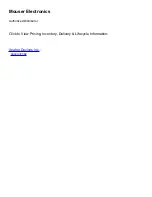
Evaluation Board User Guide
UG-207
Rev. A | Page 9 of 16
PROFILES WINDOW
07
48
1-
0
05
Figure 6. Profile Control Window
The
Profiles
window allows you to change the different profile
settings easily. Figure 6 shows the
Profiles
window for using the
single-tone mode.
SINGLE-TONE MODE
Output Freq
is used to set the frequency generated by the
DDS. The AD9910 generates a sine/cosine wave at this output
frequency.
Phase Offset
controls the phase of the DDS output. This can be
changed from 0° to 360°
with 16-bit resolution. The spin boxes
for phase offset are set to 1 bit by default. The phase offset degree
and number of bits can be changed to your preference by typing
in the text box and spin box, respectively
Amplitude SF
digitally controls the amplitude of the carrier
from the DDS. This scalar has 14 bits of resolution. Note that
this can be used in conjunction with
DAC Gain Ctrl
in the
AUX DAC Control
section (see Figure 5) to increase the
flexibility of the output amplitude. The spin boxes for amplitude
SF are set to 1 bit by default. The number of bits can be changed
to your preference by typing in the spin box.
Data Entry Windows
The
Edit output frequency
dialog box (see Figure 7) appears by
double-clicking the
Output Freq
text box in the
Profiles
window.
The
Edit output frequency
window allows you to set individual
bits in the frequency tuning word register. These bits can be typed
in decimal, hexadecimal, or binary format in the
Tuning Word
Values
area. This window also allows you to enter in a tuning
word and see the correct decimal, hexadecimal, or binary
representation for this word. The
Frequency
spin box allows
you to scroll through the different tuning words one bit at a
time using the up and down arrows.
07
48
1-
00
6
Figure 7. Edit Output Frequency Pop-Up Dialog Box

















